"When you want something, all the universe conspires in helping you to achieve it." ~ Paulo Coelho, The Alchemist
| 1. I am into GSoC | 5th May, 2023 |
| 2. Community Bonding Period | First Fortnight |
Hello World! I am into GSOC @CERN
Greetings everyone! I am humbled to share with you that I have been selected as a contributor in Google Summer of Code 2023 at CERN-HSF . I am really excited and look forward to contributing to the project “Estimating the energy cost of scientific software” .
Briefing my Project
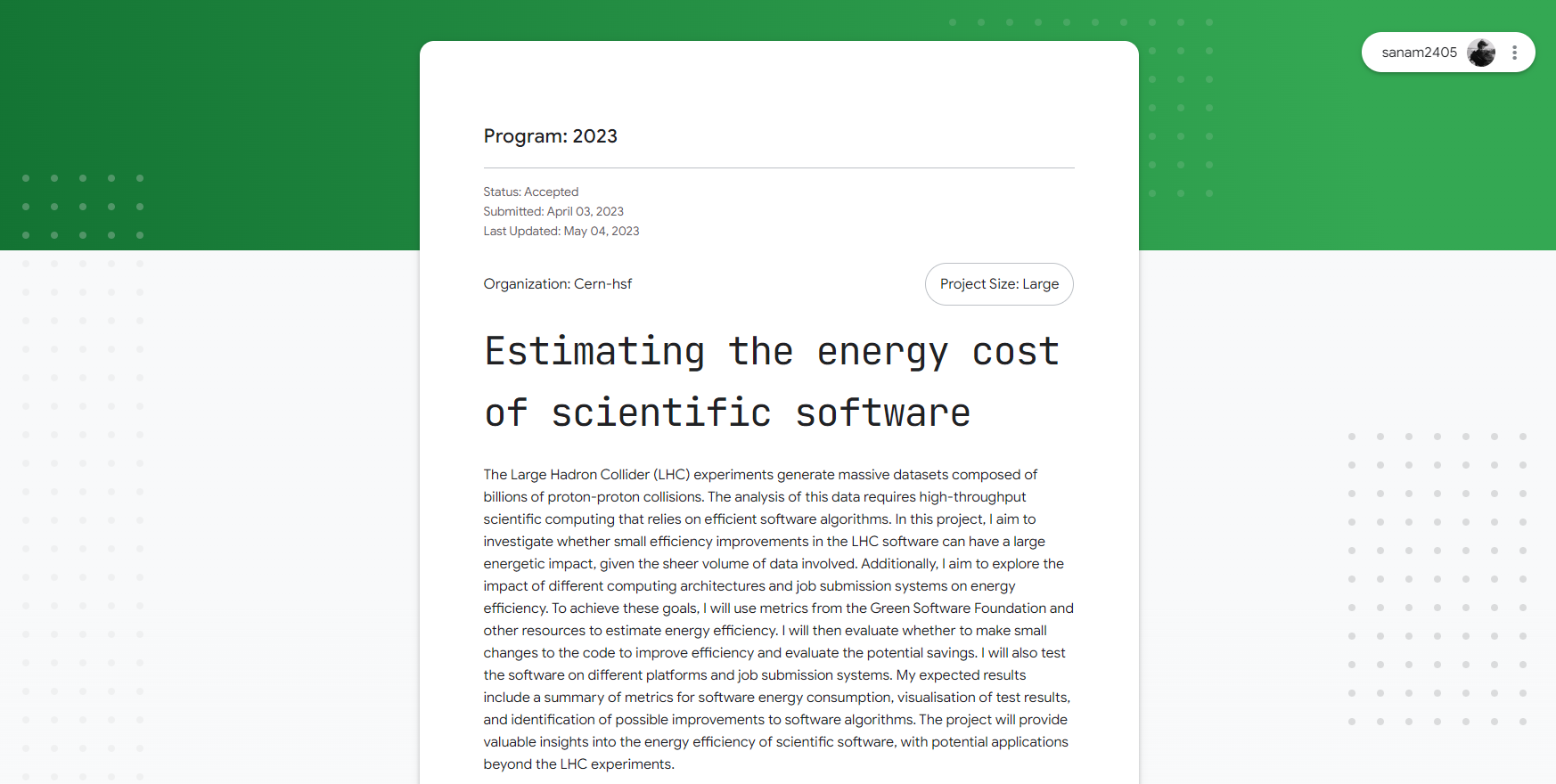
My project aims to estimate the energy consumption and energy efficiency of a scientific software that is used in the experiments at the Large Hadron Collider (LHC) and then try to optimize the software energetically. My first task is to try estimating the energy cost of the software. Various methodologies and software profiling techniques (mentioned in my GSoC Proposal ) can be used to achieve this task and I aim to explore them. The second task consists of making changes to the codebase and trying to refactor the code to check if I can optimize the energy efficiency of the software. If time permits, my third task involves testing the software on different platforms and job submission systems. Note: This particular project aims to answer a very open ended question and demands a lot of research work. Hence this is more of a research based project. On successful completion, the project will provide valuable insights into the energy efficiency of scientific high throughput softwares, with potential applications beyond the LHC experiments.
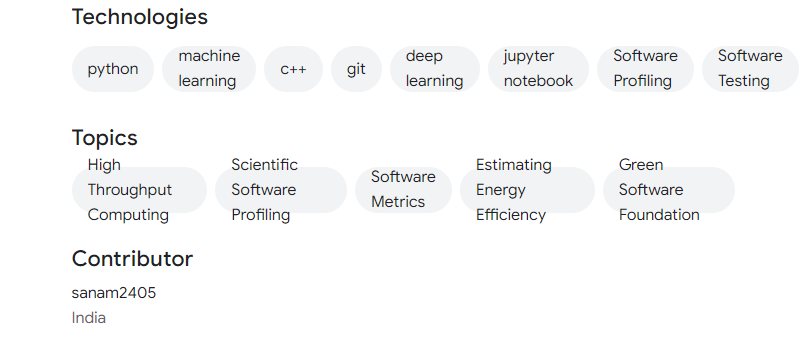
The Moment
This was the first time that I applied to GSoC. Interestingly, I took a gamble and I applied solely to this project, giving all my effort into writing this single proposal . I am happy that it paid off. I would like to mention two of my friends - Krishnaneel Dey and Anirban Mukherjee who encouraged me throughout my application process and the pre-GSoC phase. They are the ones who actually witnessed every bit of my application process and the effort that I had put in. I was at the epitome of satisfaction when I received the acceptance email. I share the moment with Krishnaneel and Anirban.
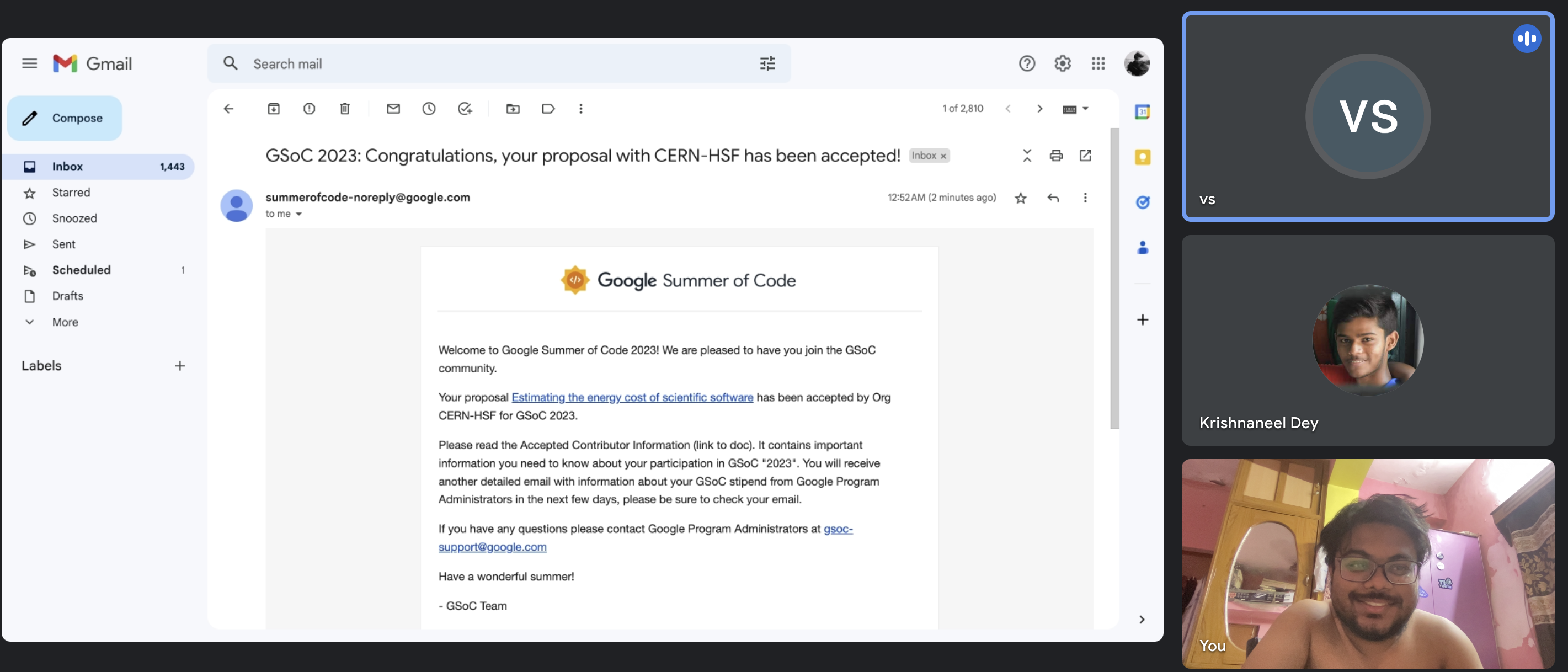
My project is mentored by Caterina Doglioni and Benedikt Hegner and I am really grateful for their guidance and valuable suggestions during the proposal drafting period. I look forward to collaborating and learning from them and complete all the tasks within the stipulated time and have a summer full of learning!
About CERN-HSF
CERN-HSF , or the High Energy Physics Software Foundation , is a non-profit organization dedicated to developing and supporting software tools for the field of high-energy physics. One of their flagship programs is the Google Summer of Code (GSoC), a global program that offers students the opportunity to work on open-source projects with mentorship and guidance from experienced developers. Through the GSoC program at CERN-HSF, students can contribute to cutting-edge software projects that support the work of high-energy physicists around the world. This is a fantastic opportunity for students to gain valuable experience in software development while contributing to the advancement of scientific research.

My Motivation and why CERN ?
Since my high school days, I've been captivated by the mysterious and awe-inspiring world of physics. There's just something about the way the universe works that never ceases to amaze me, from the fundamental principles of Newtonian Mechanics to the mind-bending concepts of Thermodynamics and Modern Physics. And there's no place on Earth where this fascination is more alive and tangible than at CERN.
Working at CERN has been my ultimate dream and aspiration for as long as I can remember. The opportunity to be a part of a team of brilliant minds from all around the world, all working towards answering some of the most fundamental existential questions that humanity has ever asked - it's the stuff of dreams. But what really drives me is the sheer enormity of the task at hand. To even begin to scratch the surface of understanding how the universe originated is a monumental feat that will require the best and brightest minds from every corner of the globe. And that's where I want to come in - I want to be a part of that effort, no matter how small my contribution may be.
I strongly believe that the research and methodology presented in my proposal have the potential to make a real impact on high throughput scientific software making them more sustainable and energy efficient. I am eager to see where this work will take us. But this is not just about research, coding or software development. This is about taking responsibility for the impact that our technology has on the environment, and doing everything we can to reduce that impact. I believe that together, we can develop scientific software that is not only efficient and effective, but also environmentally sustainable. I believe we can build a future where technology and the environment can coexist in harmony, and where we can all thrive.
Conclusion
As I embark on this journey towards GSoC at CERN, I am filled with a sense of gratitude for having come this far. But most of all, I am filled with an unquenchable passion and hunger to be a part of something truly special - something that has the potential to change the world as we know it.
The God Particle
In the depths of the Swiss-French border lies an epicenter of scientific marvels, a place where human curiosity converges with cutting-edge technology to unravel the mysteries of the universe. Welcome to CERN , the birthplace of groundbreaking discoveries that have reshaped our understanding of the cosmos. As I embark on my journey through the Google Summer of Code (GSoC) at CERN, I am both humbled and exhilarated by the opportunity to contribute and propagate the legacy of this extraordinary institution.
The Legacy of CERN
CERN, the European Organization for Nuclear Research , has long been at the forefront of scientific exploration, paving the way for revolutionary advancements that extend far beyond the boundaries of its colossal underground particle accelerators. Among its most illustrious contributions, perhaps none shine as brilliantly as the invention of the World Wide Web . Born from the visionary mind of Sir Tim Berners-Lee, this digital universe has transformed every aspect of our lives, connecting people, knowledge, and ideas across the globe. CERN's commitment to open access and collaboration birthed a platform that empowers us all. Here is how the first Webpage looked.
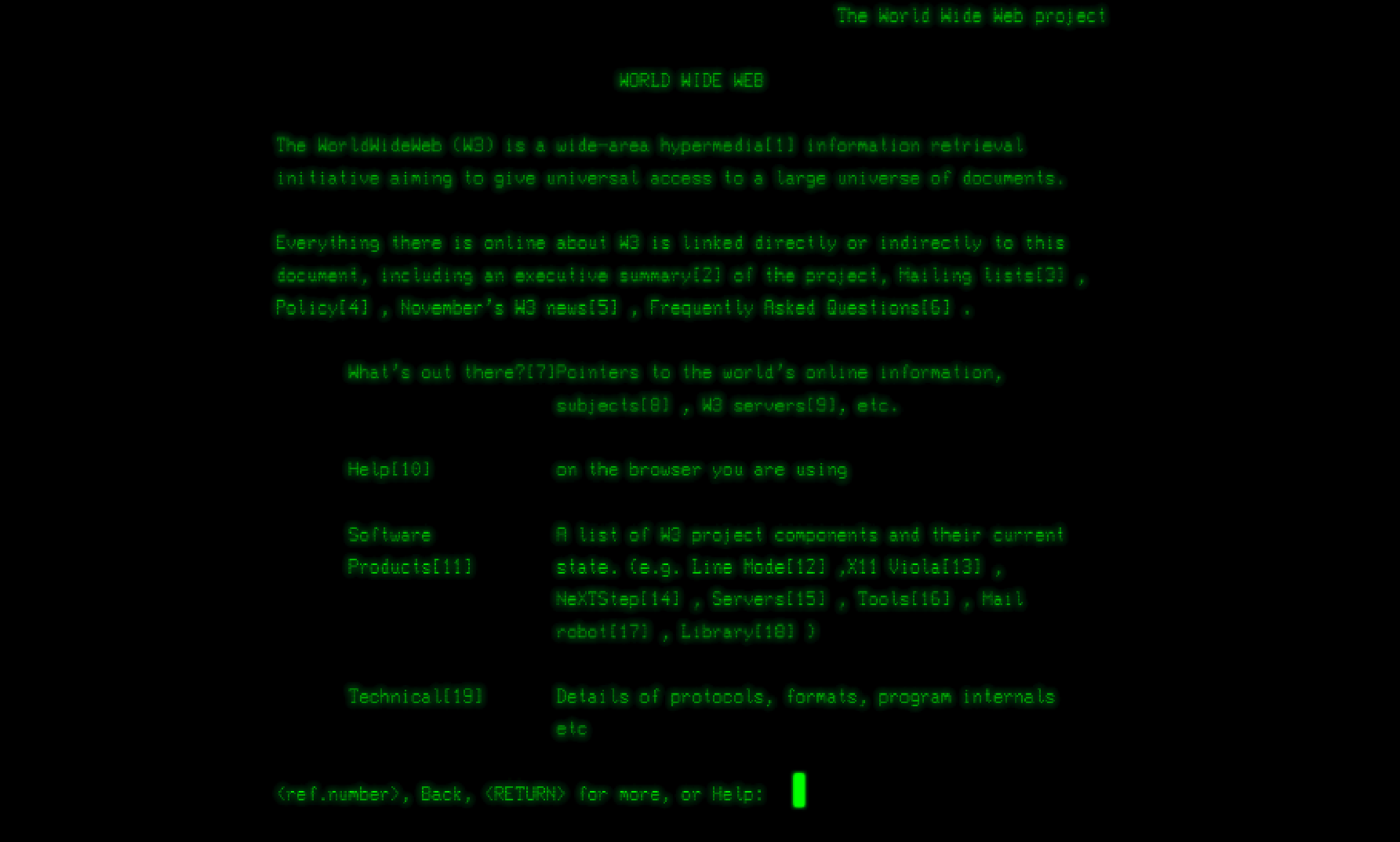
Beyond the confines of the Web, CERN's experiments continually push the boundaries of our understanding. From the enigmatic Higgs boson to the probing mysteries of dark matter and antimatter, these captivating quests hold the keys to unlocking the secrets of our universe. The diverse range of scientific disciplines converging at CERN, along with its unparalleled resources and collective brilliance, make it a cauldron of inspiration for scientists, engineers, and dreamers alike.
Unveiling the Mysteries: The Higgs Boson and the Origin of Mass
The quest for knowledge at CERN delves deep into the fundamental building blocks of the universe. Among the most captivating discoveries in recent history is the Higgs boson , a particle that plays a pivotal role in our understanding of the universe's origin and the existence of mass itself. In this chapter of my GSoC journey at CERN, I am privileged to explore the intricate world of the Higgs boson and the profound implications it holds.
The Higgs boson owes its existence to an invisible field that permeates the entire universe: the Higgs field. It is through interactions with this field that particles acquire their masses, much like a crowd navigating through a dense field of snowflakes. The concept of the Higgs field, proposed by theoretical physicists François Englert and Peter Higgs in the 1960s, revolutionized our understanding of the fundamental forces that shape our universe.
In the early moments of the Big Bang, the universe was a seething cauldron of energy and particles. As it expanded and cooled, the Higgs field, analogous to a cosmic molasses, came into being. This field imbues certain particles with mass, allowing them to take on the characteristics we observe today. However, some particles, such as photons, remain massless, gliding effortlessly through the Higgs field, untouched by its influence.
But how do we uncover the secrets of this elusive Higgs boson? Enter the Large Hadron Collider (LHC), CERN's colossal particle accelerator. With its prodigious energy, the LHC recreates conditions akin to the early universe, enabling scientists to study the behavior of particles and potentially detect the Higgs boson. This monumental effort culminated in 2012 with the discovery of the Higgs boson, a triumph that garnered François Englert and Peter Higgs the Nobel Prize in Physics in 2013.
A Trailblazer's Legacy: Satyendranath Bose and the Boson
In the annals of scientific history, there are certain individuals whose contributions transcend borders, leaving an indelible mark on our understanding of the universe. One such luminary was Satyendranath Bose , an Indian scientist hailing from the vibrant city of Calcutta. Bose's pioneering work laid the foundation for statistical techniques that would later play a pivotal role in counting the particles that populate our cosmos. Today, his name is immortalized as half the universe is named with the term "Boson" in his honor .
Born on January 1, 1894, in Calcutta, Satyendranath Bose's scientific journey commenced amidst a backdrop of intellectual fervor and cultural richness. Bose's work was characterized by his deep passion for physics and his insatiable curiosity. In the 1920s, he made a groundbreaking breakthrough in collaboration with Albert Einstein , which would lay the groundwork for an entirely new branch of physics.
Bose's seminal contribution came in the form of what is now known as Bose-Einstein statistics . These statistical techniques revolutionized the way we understand the behavior of particles, particularly those that make up the quantum world. In Bose-Einstein statistics, particles with integer spins, now called bosons, can occupy the same quantum state. This principle is in stark contrast to particles governed by Fermi-Dirac statistics, which obey the Pauli exclusion principle and possess half-integer spins.
The profound implications of Bose's work cannot be overstated. His statistical techniques were instrumental in describing and predicting the behavior of fundamental particles, shedding light on phenomena such as superfluidity and superconductivity. Bose's insights not only advanced our understanding of the quantum world but also paved the way for subsequent discoveries and developments in the field of particle physics.
In a fitting tribute to his contributions, the term "Boson" was coined to honor Satyendranath Bose. This moniker is bestowed upon the class of particles that obey Bose-Einstein statistics. From the Higgs boson to the photon, the universe is replete with these particles, perpetuating Bose's legacy and reminding us of his invaluable contributions to the world of physics.
As a Bengali and a resident of Calcutta , I cannot help but feel an overwhelming sense of pride and inspiration. To hail from the same city that nurtured a scientific luminary of Bose's stature is a testament to the intellectual heritage and rich cultural tapestry of my homeland. The city of Calcutta, with its vibrant intellectual and artistic community, has long been a crucible of innovation and a wellspring of talent.
Captivating Experiments: Exploring the LHCb, CMS, and ATLAS Experiments
Within CERN's labyrinthine tunnels lies a world brimming with awe-inspiring experiments. Picture the Large Hadron Collider (LHC), an engineering marvel, a 27 kilometers long tunnel, 100 meters underneath the ground that propels particles to incredible speeds and smashes them together, recreating conditions that mimic the early moments of our universe. This scientific voyage not only expands our knowledge but also fuels innovation in fields as diverse as medicine, materials science, and environmental research.
The colossal infrastructure of CERN, where scientific dreams are transformed into reality, three remarkable experiments stand out: LHCb , CMS , and ATLAS . These groundbreaking projects, conducted at the Large Hadron Collider (LHC), delve into the deepest realms of particle physics, aiming to decipher the mysteries of the universe. I am exhilarated to contribute to the optimization of a software employed in the ATLAS Experiment , a small attempt from my part to contribute to the advancement of human knowledge. To know about the experiments in a fun way, here are two songs, the Large Hadron Rap and the ATLAS Boogie.
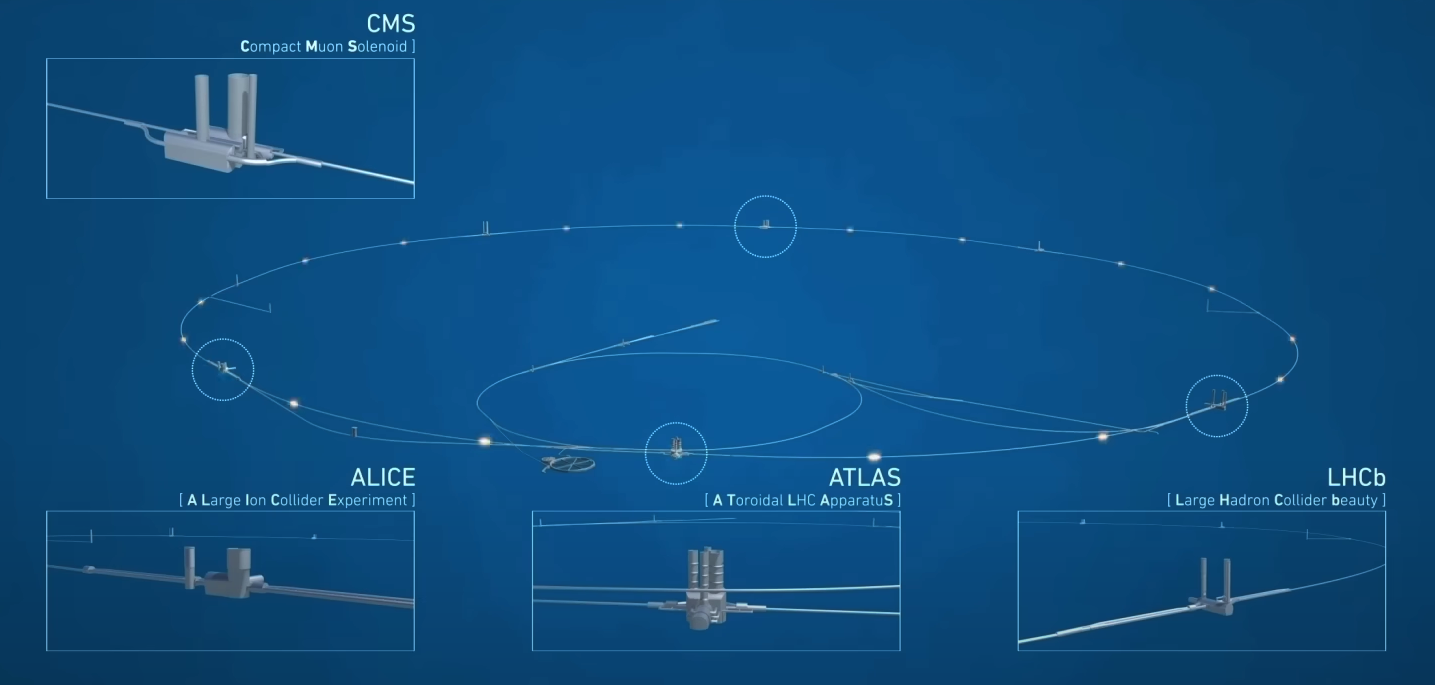
The LHCb experiment, standing for Large Hadron Collider beauty, is dedicated to investigating the subtle asymmetries between matter and antimatter. By studying the behavior of particles containing beauty quarks, the experiment seeks to shed light on the puzzling dominance of matter in our universe. With its intricate detector system, LHCb provides invaluable insights into the physics beyond the Standard Model, unraveling the secrets hidden in the decay patterns of these elusive particles.
CMS, the Compact Muon Solenoid, represents another marvel of scientific ingenuity at CERN. This experiment explores the properties of the Higgs boson and searches for new physics phenomena, aiming to deepen our understanding of the fundamental forces that govern the cosmos. With its gigantic detector, CMS meticulously records the tracks, energy, and properties of particles produced by high-energy collisions, enabling scientists to reconstruct and analyze the intricate details of these interactions.
Lastly, we have the ATLAS experiment, a monumental undertaking designed to uncover the deepest layers of nature's fabric. ATLAS, which stands for A Toroidal LHC ApparatuS , focuses on an extensive range of research topics, including the search for new particles, the study of the Higgs boson, and the exploration of the mysteries of dark matter. Spanning for a length of 46 meters with a diameter of 25 meters, the ATLAS detector records and analyzes particle collisions with extraordinary precision, providing a window into the fundamental processes that shape our universe. Here you can have a virtual tour of the Atlas Detector.

Epilogue
The discovery of the Higgs boson opened up a new era of exploration, offering insights into the origin of mass and the very fabric of our universe. Its existence confirms the validity of the Higgs mechanism, which postulates the Higgs field's fundamental role in the cosmic dance of particles and forces. By understanding how particles acquire mass, scientists can now delve deeper into the mechanisms governing the universe's evolution from its primordial state to the complex cosmos we observe today.
The implications of the Higgs boson's discovery reach far beyond theoretical physics. From advancements in particle physics and cosmology to practical applications in technology and engineering, this breakthrough has sparked innovation across disciplines. The Higgs boson has become a linchpin in our quest to comprehend the enigmas of the universe, guiding us toward a more profound understanding of our existence.
In the grand tapestry of scientific exploration, as we delve
into the depths of the universe, I am reminded of the profound
words of Rabindranath Tagore, the celebrated poet and
philosopher and his song -
Akash Bhora Surjyo Tara
(আকাশভরা সূর্য-তারা)
I keep a translation of the song in English for my readers:
This sky is illuminated by the Sun and the stars
The world, full of life
Amidst this effervescence I have found myself
I have found my place
And hence, overwhelmed
My song awakens
It rises to fill up the sky
Cadenced by the swing of the endless time
At the feel in my pulse
The rhythm of creation
The source of my life
The blood rush in my veins I have felt
And hence, overwhelmed
My song awakens
It rises to fill up the sky
My feet have caressed the grass
As I walked in the woods
The fragrance of flowers, often starling
And filling my heart with joy
Everywhere I looked, I saw
Gifts of happiness!
And hence, overwhelmed
My song awakens
I have pricked up my ears, my eyes in inquisitiveness
I have poured my life into Mother Earth's bosom
The unknown amidst the know
I have searched
And hence, overwhelmed
My song awakens
It rises to fill up the sky